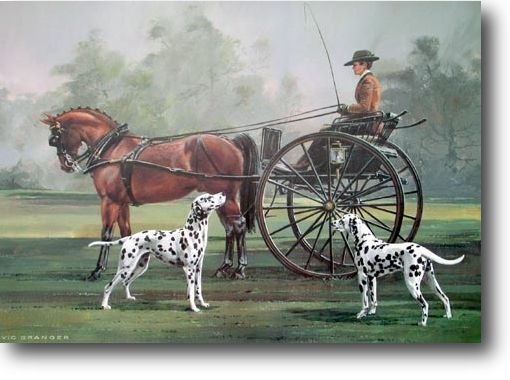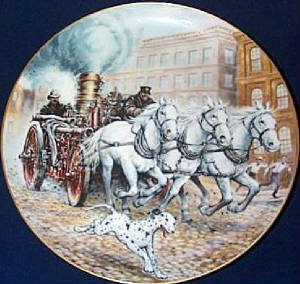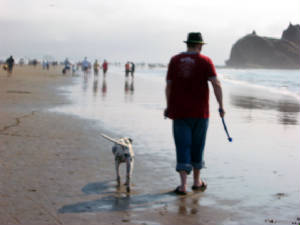|
A Long and Mysterious History:
Although it is impossible to know the exact age of the Dalmatian breed, it is almost certain that they are an ancient
dog. The discovery of hieroglyphics in Egypt depicting spotted dogs that resemble Dalmatians has only supported
this suspicion. Besides, their unique and distinguished appearance makes it highly unlikely that they were created from
mixing other breeds.
Although there have been many speculations surrounding the Dalmatians original homeland, we must admit that this fact is
lost to time. Some say India, others Africa, and still others were so convinced that they were from modern day Croatia
that they gave them the name "Dalmatian" (after the region of Dalmatia). Perhaps the key to this mystery is that Dalmatians
were the companions of nomadic tribes. In relatively recent history, for example, Dalmatians have been known to
be favored by travelling bands of "Gypsies". They also have a history of circus performing, and perhaps travelled from region
to region with travelling entertainers.
Because of their natural affinity for horses and their impressive running endurance, Dalmatians became popular companions
for carriage horses. They easily ran alongside the horses, and enjoyed the opportunity to go on long trips.
As news of these attractive traits spread, Dalmatians became increasingly popular with European aristocrats. It is often
said that Dalmatians still have "aristocratic" personalities due to their long stint in high-society.

It is because of their experience as carriage dogs that Dalmatians were brought into firehouses. Back when fire
engines were pulled by horses, firemen often needed the dogs to keep the horses calm amidst the chaos, to help clear the streets
so the engine could pass, and of course for companionship and comaraderie. Dalmatians were also particularly well suited
for this job because of their famously brave demeanor.

|
|
Dalmatians Today...
Although Dalmatians are sometimes still kept in firehouses as mascots, the invention of the automobile and modern fire
engines has eliminated the job the dogs used to do. Occasionally you still see a Dalmatian or two performing in a circus,
but the increasing awareness of animal rights has also meant a decline in this phenomenon. Dalmatians these days are
perfectly happy "just" being companions.

Dalmatians have still retained their ancestors' traits, however. They are still naturally comfortable with horses
and still love to run. They also often have an exclusive and aristocratic nature, and I'm sure my Dalmatians would feel
perfectly at home in some Edwardian mansion. They are also born entertainers, and I'm almost certain that my Lola had
ancestors in the circus business because of her goofy comedic personality!
Dalmatian Health...
Dalmatians are naturally a very healthy breed. Common health problems in other breeds, such as hip dysplasia and seizures
disorders, are virtually unknown in Dalmatians. They are also a relatively long-lived breed, and generally don't begin
experiencing the normal problems of old age until they are around 12 years old. The general life expectancy is around
15 years, and many Dalmatians make it even longer. With regular visits to the vet and a healthy lifestyle, you can expect
your Dal friend to be around a good long time!
Deafness: This is perhaps the biggest health problem for Dalmatians. They experience a much
higher occurence of deafness than other breeds (about 10%), and it is directly linked to their unique white coloring and a
genetic mutation of the inner-ear. Responsible Dalmatian breeders have their pups screened for deafness using the
BAER test, and would never sell a deaf pup without informing the adopter, but if you suspect you have a deaf Dalmatian
it is relatively easy to have him or her tested. Unfortunately, many deaf Dalmatian puppies are euthanized simply
because they cannot hear. Deaf dogs can make wonderful pets for families that have the patience and knowledge
of how to deal with it, so I would STRONGLY recommend exploring other options before euthanizing an otherwise healthy
Dalmatian! Both of my Dalmatians are deaf, and with some special hand-signal training they are wonderfully behaved and
fully functional members of my family!
Bladder Stones: Dalmatians are the only dogs that can suffer from bladder stones, and like deafness
it is linked to their lack of pigmentation. Dalmatians produce naturally acidic urine, which can lead to the stones.
If you notice changes in your Dal's urination habits, including frequent accidents or painful urination, you should have him
or her screened for bladder stones immediately! Although your Dal may pass the stone(s) without problem, if left
unchecked it can lead to major health problems. Before I adopted him, my Dal Duke was found abandoned with the
worst case of urine blockage the vet had ever seen, and it almost proved fatal for the poor guy!
Vestibular Disease: The term "vestibular disease" is generally used to describe any abnormality in the
vestibule (the mechanism in the inner-ear that controls our ability to interpret our position in space) that cannot be explained
by stroke, brain tumor, or any other major neurological event. The causes of vestibular disease range from infection,
to blockage, to idiopathic, and the symptoms are reminiscent of a stroke: leaning to one side, loss of balance,
head-tilt, and general disorientation. Dalmatians tend to have sensitive inner-ears and are therefore possibly
more prone to vestibular disease, although the symptoms generally pass after about a week.
|

